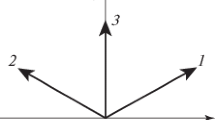Abstract
The growth of two-dimensional disturbances generated in a supersonic (M∞ = 6) boundary layer on a flat plate by a periodic perturbation of the injection/suction type is investigated on the basis of a numerical solution of the Navier-Stokes equations. For small initial perturbation amplitudes, the secondmode growth rate obtained from the numerical modeling coincides with the growth rate calculated using linear theory with account for the non-parallelism of the main flow. Calculations performed for large initial perturbation amplitudes reveal the nonlinear dynamics of the perturbation growth downstream, with rapid growth of the higher multiple harmonics.
Similar content being viewed by others
REFERENCES
T. C. Lin, W. R. Grabowsky, and K. E. Yelmgren,“The search for optimum configurations for re-entry vehicles,” J. Spacecraft and Rockets. 21, No. 2, 142–149(1984).
P. V. Tartabini, R. A. Lepsch, J. J. Korte, and K. E. Wurster, “A multidisciplinary performance analysis of a liftingbody single-stage-to-orbit vehicle,” AIAA Paper No. 2000–1045(2000).
H. L. Reed, R. Kimmel, S. Schneider, and D. Arnal, “Drag prediction and transition in hypersonic flow,” AIAA Paper No. 97–1818(1997).
S. A. Gaponov and A. A. Maslov, Perturbation Development in Compressible Flows[in Russian], Nauka, Novosibirsk (1992).
M. Morkovin, “Bypass transition to turbulence and research desiderata,” Transition in turbulence: NASA, CP-2386, 161–199(1985).
N. A. Jaffe, T. T. Okamura, and A. M. O. Smith, “Determination of spatial amplification factors and their application to predicting transition,” AIAA J., 8, No. 2, 301–308(1970).
C. D. Pruett and C. L. Chang, “Spatial direct numerical simulation of high-speed boundary layer flows. Pt. II: Transition on a cone in Mach 8 flow,” Theoret. Comput. Fluid Dynamics, 7, No. 5, 397–424(1995).
X. Zhong, “Direct numerical simulation of hypersonic boundary-layer transition over blunt leading edges. Pt I: A new numerical method and validation,” AIAA Paper No. 97–0755(1997).
S. H Hu and X. Zhong, “Linear stability of hypersonic flow over a parabolic leading edge,” AIAA Paper No. 97–2015(1997).
X. Zhong, “Receptivity of hypersonic boundary layers to free-stream disturbances,” AIAA Paper No. 2000–0531(2000).
Y. Ma and X. Zhong, “Direct numerical simulation of instability of nonequilibrium reacting hypersonic boundary layers,” AIAA Paper No. 2000–0539(2000).
Y. Ma and X. Zhong, “Numerical simulation of receptivity and stability of nonequilibrium reacting hypersonic boundary layers,”AIAA Paper No. 2001–0892(2001).
X. Zhong and Y.Ma, “Receptivity and linear stability of Stetson’sMach 8 blunt cone stability experiments,” AIAA Paper No. 2002–2849(2002).
K. F. Stetson, E. R. Thompson, J. C. Donaldson, and L. G. Siler, “Laminar boundary layer stability experiments on a cone at Mach 8. Pt 2: Blunt cone,” AIAA Paper No. 84–0006(1984).
K. F. Stetson and R. L. Kimmel, “On hypersonic boundary layer stability,” AIAA Paper No. 92–0737(1992).
S. K. Godunov, “Finite-differencemethod for the numerical calculation of discontinuous solutions of the equations of hydrodynamics,” Math. Sb., 47, No. 3, 271–306(1959).
V. P. Kolgan, “The application of the minimum-derivative principle to the construction of finite-difference schemes for the calculation of discontinuous solutions of the equations of gasdynamics,” Uchen. Zap. TsAGI, 3, No. 6, 68–77(1972).
P. L. Roe, “Approximate Riemann solvers, parameter vectors, and difference scheme,” J. Comput. Phys., 43, No. 2, 357–372(1981).
I. U. Babaev, V. A. Bashkin, and I. V. Egorov, “Numerical solution of the Navier-Stokes equations using iterative methods of variational type,” Zh. Vych. Matem. Mat. Phys., 34, No. 11, 1693–1703(1994).
V. A. Bashkin, I. V. Egorov, and D. V. Ivanov, “The application of Newton’s method to the calculation of internal hypersonic separated flows,” Prikl. Matem. Tekh. Fiz., 38, No. 1, 30–42(1997).
V. R. Gushchin and A.V. Fedorov, “Short-wave instability in the shock layer of a perfect gas,” Izv. Akad Nauk SSSR, Mekh. Zhidk. Gaza, 1, 10 (1989).
A. V. Fedorov and A. P. Khokhlov, “Prehistory of instability in a hypersonic boundary layer,” Theoret. Comput. Fluid Dynamics, 14, No. 6, 359–375(2001).
A. V. Fedorov and A. P. Khokhlov, “Receptivity of hypersonic boundary layer to wall disturbances,” Theoret. Comput. Fluid Dynamics, 15, No. 4, 231–254(2002).
S. A. Gaponov, “The flow non-parallelism effect on the development of perturbations in a hypersonic boundary layer,” Izv. Akad. Nauk SSSR, Mekh. Zhidk. Gaza, No. 2, 26 (1980).
C. D. Pruett and T. A. Zang, “Direct numerical simulation of laminar breakdown in high-speed, axisymmetric boundary layer,” AIAA Paper No. 92–0742(1992).
K. F. Stetson and R. L. Kimmel, “On the breakdown of a hypersonic boundary layer,” AIAA Paper No. 93–0896(1993).
A. N. Shiplyuk, A. A. Maslov, and N. D. Chokani, “Nonlinear interactions of second mode instability with natural and artificial disturbances,” AIAA Paper No. 2003–0787(2003).
Additional information
Translated from Izvestiya Rossiiskoi Academii Nauk, Mekhanika Zhidkosti i Gaza, No. 6, 2004, pp. 33–44.Original Russian Text Copyright © 2004 by Egorov, Sudakov, Fedorov
Rights and permissions
About this article
Cite this article
Egorov, I., Sudakov, V. & Fedorov, A. Numerical modeling of perturbation propagation in a supersonic boundary layer. Fluid Dyn 39, 874–884 (2004). https://doi.org/10.1007/s10697-004-0004-1
Received:
Issue Date:
DOI: https://doi.org/10.1007/s10697-004-0004-1



